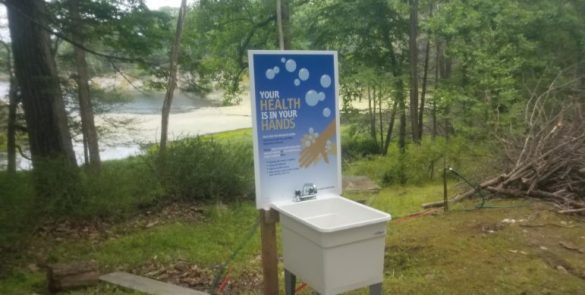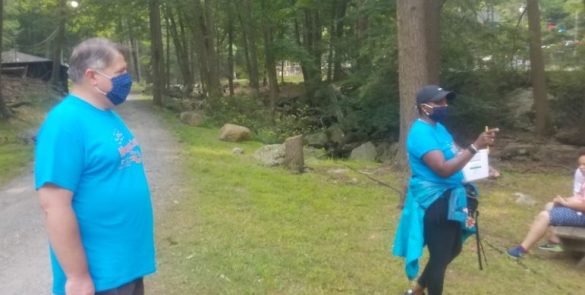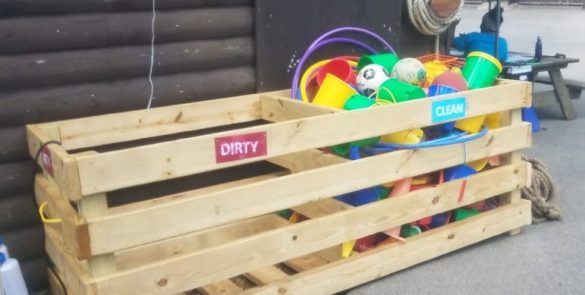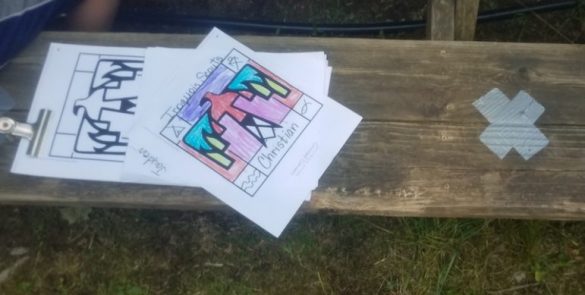
Fewer Kids, More Clorox and Make Your Own S’mores
Deep in the cool woods of Harriman State Park, along the sandy shoreline of an all-but-empty lake, squeals of delight break through the quiet of a steamy summer Wednesday.
“On day one, it was very quiet. Kids were afraid to take off their masks. But by midday you started to hear that sound,” says Mike Halpern, pointing toward the screeching kids splashing through their swim lesson. “And there is nothing better than that sound.”
Halpern is the director of youth services for the Bronx-based Mosholu Montefiore Community Center (MMCC), which for 75 years has operated a summer day camp, and for a dozen years has held it in one of the dozens of group camping sites that dot Harriman’s 47,527 acres.
After throwing kids out of school and into a massive experiment in online learning four months ago, COVID-19 has also invaded the precious months of childhood summer. In Orange County alone, there are normally 65 to 70 camps operating during the summer, according to a spokesman for the county government. This year, there are 16.
Mosholu Day Camp, located between a windy forest road and Upper Lake Cohasset, is up and running as it has been for decades—but in a very, very different way. There are fewer kids and special rules. Some rituals of day-camp summer have been mothballed and others have been significantly altered.
The day City Limits visited Halpern’s camp, Mayor de Blasio and schools Chancellor Richard Carranza outlined their strategy for reopening schools in September. Limited density, staggered schedules, mask rules, distancing protocols and online learning will be part of the reality facing the city’s nearly 1 million schoolchildren after Labor Day. What the day-to-day school experience will be like, and how effective learning can be in such an environment, are open questions.
In some ways, the day camps that have survived the first wave of COVID-19 indicate just how different life will be for kids when school resumes. They also demonstrate that the essence of a youth activity can, with a lot of planning, be preserved.

Fear, Loss and Finances
Mosholu Day Camp, which draws from upper Manhattan and the Bronx as well as Rockland and Westchester counties and offers two to eight weeks of camp, is operating at about a third its normal size. That’s largely by design, although fear and feelings that the restrictive environment in camp is less valuable might have reduced the applicant pool.
“At first parents were apprehensive. ‘I’m paying the same price,’ they’d say. They ultimately did understand,” Halpern says. “Some people pulled out because they were scared. They came back.”
He says he has had to turn some campers away because the camp needed to reduce density, especially on the buses. Each bus used to carry 45 to 50 kids but now it’s capped at 30, with no one but siblings sharing seats. Masks and hand-sanitizer are mandatory for everyone on the bus, and temperature checks and questionnaires are part of the daily boarding routine. The Monday after Independence Day, a child who told the bus counselor that he had visited relatives in Atlanta that weekend was barred from boarding and sent home to observe the mandatory quarantine.
COVID-19 affected more than children’s schooling, of course. “There was a lot of loss. We definitely heard of campers who had people die in their homes: parents, grandparents. There were families who pulled out because they couldn’t pull it together, because of a death, or finances.” This year parents can buy a couple weeks of camp at a time; usually the camp requires payment for the full summer up front, “but I knew that was impossible this year,” Halpern says.
MMCC required testing for staff, which of course doesn’t eliminate the possibility of a worker taking ill, but has been helpful for staff cohesion. The staff is slightly smaller this year, and there are no counselors-in-training.
Other camps faced insurmountable challenges to opening. Those that used vans rather than buses would have encountered huge cost increases to get the necessary spacing in their day-to-day transportation. Camps that relied on international staff simply couldn’t find the person-power. Others may simply have been afraid that camp couldn’t be done safely.
Two weeks into the summer, MMCC’s effort seems to be going well. But this is not a year to assume nothing more will change. “We all have unknowns,” Halpern says. “I think we all pay attention – my senior staff – to the news. We are open to, if we hear new things, we put [new practices] in place.”

Plan, adapt, plan some more
MMCC’s planning for how to handle COVID-19 began in March. Halpern and his leadership team kept a diary of the questions and issues they encountered, and how they decided to address them. “Our journal turned into what we now call our operating guidelines,” he says. Directives from the U.S. Centers for Disease Control and Prevention, then American Camp Association and the New York State Department of Health also helped shape the camp’s approach, delineating “good,” “better” and “best” practices. In some areas, Halpern says, MMCC was ahead of the game—for instance, a camp only needs to have an emergency medical technician on hand, but MMCC planned to have a nurse. They were behind in others. “What we had to do was adapt,” he says. “There were some areas where we had to really work to get to ‘better.’”
The differences between 2020 and a “normal” camp year are plainly visible. Handwashing reminders are all over the place, and there are handwashing sinks in weird places, like the middle of the sports field. There’s a bin for “dirty” balls at a washing station, next to a bin for “clean” ones. Each of the camp’s 50 staff members is wearing a mask. Signs direct a one-way flow through the dining hall where, according to Halpern, the rush of kids into and out of the structure “used to be more haphazard.”
Kids are not wearing masks, because they spend all day every day with same group of seven other kids and a single counselor. “The biggest reality is our groups used to be much bigger,” with 16 kids and two or three counselors, Halpern says. And this year, everything is outside: For instance, the massive drama building—site of so many theatrical debuts over the years—sits empty. When it rains, each group can retreat to a building that is reserved solely for its use, although there’s not much to do there, and on a rainy Friday, the camp sent kids home early.
Programming is also different. Every station, from arts & crafts to archery, is active for one activity period, followed by one period off for cleaning. Kids must bring their own lunch; when s’mores day hits, each kid will make her or his own. There are no overnight stays (a traditional treat for older campers) or field trips. The daily “pow wow” is no more, and the late-night cookout that used to occur for each camp session is on hiatus.
At the archery station, a group of girls took up their bows and began firing shots into the targets. When one had trouble getting the pull right, her instructor stepped back, put on a face shield over his mask, then stepped forward to guide her. Nearby, at the station for Native American culture, kids sat at picnic tables at spots marked by a duct-taped X. Their instructor, Nicole Manning, who has worked at the camp for 15 years, is also a school teacher—and after the tedium of distance learning this spring, she wasn’t sure what camp would be like. “I thought the kids would be really difficult or fearful. But they seem be acclimating to life at camp,” she says. The restrictions and new practices are an inescapable shift, but she says the basics remain in place. “I don’t think it really changed it.”
Where it gets tough is when closeness and contact are essential to the activity—like a swim instructor guiding your elbow to show how it is supposed to come out of the water when doing the crawl. St the waterfront, “we are doing instruction. We’re just staying away from touching the kids. It’s not as high quality,” Halpern acknowledges. “But we have a huge number of non-swimmers. So water familiarity is sometimes more important than technique.”
A moment later, two groups of campers exit the water at the same time, mixing together in close proximity as they walk off the docks and up the sand. Halpern notes the issue. Something new to plan around.
Temp Checks Three Times a Day
A look at another Harriman camp indicates broad similarities but also room for variation in how youth programs deal with the COVID-19 risk.
Three miles through the woods (and eight miles by road) from Mosholu Day Camp is YMCA Camp Discovery. It is also running a smaller program this summer: Instead of 280 campers divided into 14 groups of 20 with two counselors per group, the camp is hosting 150 campers split into 15 groups of 10 campers each with a single counselor.
As at MMCC’s camp, the counselors are masked all the day, but kids do not wear masks unless it is raining and they must go inside their group’s assigned cabin. There are breaks through the day to allow kids to scrub their hands, and a dedicated sanitation worker roams the camp sterilizing things.
While all the standard activities are on the menu, there are special rules for most of them: boating, swimming, archery, fishing, sports and arts & crafts.
YMCA camp directors tell City Limits they are checking kids’ temperatures three times a day: when they arrive, at lunchtime and when they depart, and the results are kept in a log. Arrival and departure are by car: As the camp’s website announces, “There is no bus transportation this year due to COVID-19 prevention protocols.”

Lessons for learning?
Too soon for kids and the kid inside many of us, summer will be over, and camps like MMCC’s and the YMCA’s will be boarded up to await the 2021 season. By next July, the world might be more recognizable. Halpern says some of the practices adopted this summer ought to be retained—like more attention to cleaning and handwashing—and others, like the smaller and more intimate groups—would be nice to keep if the camp could afford it.
Back in the Norwood section of the Bronx, MMCC shares a block with the flagship Montefiore hospital and the public North Central Bronx Hospital. In a lot between MMCC and Monte is where two refrigerated trucks were parked for many weeks to provide overflow morgue space. The community center operates a food pantry. It normally serves 200 families a week. During the spring, it saw as many as 500 a day. In that environment, whether for summer camp or its regular operations, all nonprofits could use more resources.
Asked if there were lessons schools might take from how camps have responded to COVID, Halpern—who taught for three decades—is doubtful. “I don’t know how they’re going to do it,” he says, thinking of hallways, bathrooms, other places where kids mix and the large numbers of students most schools have to manage, even with different cohorts. “Here, I can learn in two seconds what someone’s temperature was this morning.”
He was on his way to a meeting about the end of summer Olympics, a tradition that will be a challenge to stage this year but that Halpern thinks is doable. The annual carnival is already booked, albeit with time set aside for cleaning each station between waves of kids. The key to offering youth services after COVID is, he says: “If you’re organized you can do it.”
